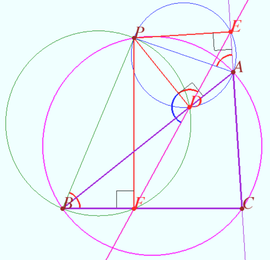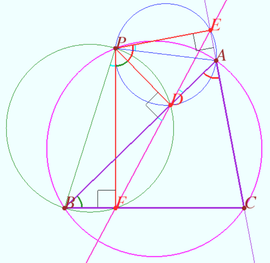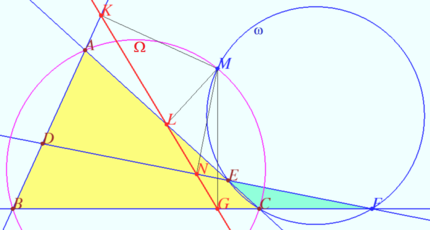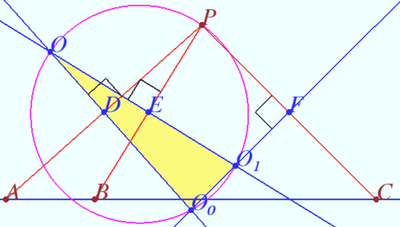Difference between revisions of "Simson line"
(→Proof) |
Sharonwang (talk | contribs) m |
||
| (15 intermediate revisions by one other user not shown) | |||
| Line 2: | Line 2: | ||
[[File:Simsonline.png]] | [[File:Simsonline.png]] | ||
| − | |||
| − | |||
==Simson line (main)== | ==Simson line (main)== | ||
| − | [[File:Simson line.png| | + | [[File:Simson line.png|270px|right]] |
| − | Let a triangle <math>\triangle ABC</math> and a point <math>P</math> be given. Let <math>D, E,</math> and <math>F</math> be the foots of the perpendiculars dropped from P to lines AB, AC, and BC, respectively. | + | [[File:Simson line inverse.png|270px|right]] |
| + | Let a triangle <math>\triangle ABC</math> and a point <math>P</math> be given. | ||
| + | |||
| + | Let <math>D, E,</math> and <math>F</math> be the foots of the perpendiculars dropped from P to lines AB, AC, and BC, respectively. | ||
Then points <math>D, E,</math> and <math>F</math> are collinear iff the point <math>P</math> lies on circumcircle of <math>\triangle ABC.</math> | Then points <math>D, E,</math> and <math>F</math> are collinear iff the point <math>P</math> lies on circumcircle of <math>\triangle ABC.</math> | ||
| Line 13: | Line 14: | ||
Let the point <math>P</math> be on the circumcircle of <math>\triangle ABC.</math> | Let the point <math>P</math> be on the circumcircle of <math>\triangle ABC.</math> | ||
| − | <math>\angle BFP = \angle BDP = 90^\circ \implies BPDF</math> is cyclic <math>\implies \angle PDF = 180^\circ – \angle CBP.</math> | + | |
| − | <math>\angle ADP = \angle AEP = 90^\circ \implies AEPD</math> is cyclic <math>\implies \angle PDE = \angle PAE.</math> | + | <math>\angle BFP = \angle BDP = 90^\circ \implies</math> |
| + | |||
| + | <math>BPDF</math> is cyclic <math>\implies \angle PDF = 180^\circ – \angle CBP.</math> | ||
| + | |||
| + | <math>\angle ADP = \angle AEP = 90^\circ \implies</math> | ||
| + | |||
| + | <math>AEPD</math> is cyclic <math>\implies \angle PDE = \angle PAE.</math> | ||
<math>ACBP</math> is cyclic <math>\implies \angle PBC = \angle PAE \implies \angle PDF + \angle PDE = 180^\circ</math> | <math>ACBP</math> is cyclic <math>\implies \angle PBC = \angle PAE \implies \angle PDF + \angle PDE = 180^\circ</math> | ||
| + | |||
<math>\implies D, E,</math> and <math>F</math> are collinear as desired. | <math>\implies D, E,</math> and <math>F</math> are collinear as desired. | ||
| + | |||
| + | <i><b>Proof</b></i> | ||
Let the points <math>D, E,</math> and <math>F</math> be collinear. | Let the points <math>D, E,</math> and <math>F</math> be collinear. | ||
| − | <math>AEPD</math> is cyclic <math>\implies \angle APE = \angle ADE, \angle | + | <math>AEPD</math> is cyclic <math>\implies \angle APE = \angle ADE, \angle DPE = \angle BAC.</math> |
| + | |||
<math>BFDP</math> is cyclic <math>\implies \angle BPF = \angle BDF, \angle DPF = \angle ABC.</math> | <math>BFDP</math> is cyclic <math>\implies \angle BPF = \angle BDF, \angle DPF = \angle ABC.</math> | ||
<math>\angle ADE = \angle BDF \implies \angle BPA = \angle EPF</math> | <math>\angle ADE = \angle BDF \implies \angle BPA = \angle EPF</math> | ||
| − | <math>= \angle BAC + \angle ABC = 180^\circ – \angle ACB \implies ACBP</math> is cyclis as desired. | + | |
| + | <math>= \angle BAC + \angle ABC = 180^\circ – \angle ACB \implies</math> | ||
| + | |||
| + | <math>ACBP</math> is cyclis as desired. | ||
| + | |||
| + | '''vladimir.shelomovskii@gmail.com, vvsss''' | ||
| + | |||
| + | ==Simson line of a complete quadrilateral== | ||
| + | [[File:Simson complite.png|430px|right]] | ||
| + | Let four lines made four triangles of a complete quadrilateral. In the diagram these are <math>\triangle ABC, \triangle ADE, \triangle CEF, \triangle BDF.</math> | ||
| + | |||
| + | Let <math>M</math> be the Miquel point of a complete quadrilateral. | ||
| + | |||
| + | Let <math>K, L, N,</math> and <math>G</math> be the foots of the perpendiculars dropped from <math>M</math> to lines <math>AB, AC, EF,</math> and <math>BC,</math> respectively. | ||
| + | |||
| + | Prove that points <math>K,L, N,</math> and <math>G</math> are collinear. | ||
| + | |||
| + | <i><b>Proof</b></i> | ||
| + | |||
| + | Let <math>\Omega</math> be the circumcircle of <math>\triangle ABC, \omega</math> be the circumcircle of <math>\triangle CEF.</math> Then <math>M = \Omega \cap \omega.</math> | ||
| + | |||
| + | Points <math>K, L,</math> and <math>G</math> are collinear as Simson line of <math>\triangle ABC.</math> | ||
| + | |||
| + | Points <math>L, N,</math> and <math>G</math> are collinear as Simson line of <math>\triangle CEF.</math> | ||
| + | |||
| + | Therefore points <math>K, L, N,</math> and <math>G</math> are collinear, as desired. | ||
| + | |||
| + | *[[Miquel's point]] | ||
| + | *[[Steiner line]] | ||
| + | '''vladimir.shelomovskii@gmail.com, vvsss''' | ||
| + | |||
| + | ==Problem== | ||
| + | [[File:Problem on Simson line.png |400px|right]] | ||
| + | |||
| + | Let the points <math>A, B,</math> and <math>C</math> be collinear and the point <math>P \notin AB.</math> | ||
| + | |||
| + | Let <math>O,O_0,</math> and <math>O_1</math> be the circumcenters of triangles <math>\triangle ABP, \triangle ACP,</math> and <math>\triangle BCP.</math> | ||
| + | |||
| + | Prove that <math>P</math> lies on circumcircle of <math>\triangle OO_0O_1.</math> | ||
| + | |||
| + | <i><b>Proof</b></i> | ||
| + | |||
| + | Let <math>D, E,</math> and <math>F</math> be the midpoints of segments <math>AB, AC,</math> and <math>BC,</math> respectively. | ||
| + | |||
| + | Then points <math>D, E,</math> and <math>F</math> are collinear <math>(DE||AB, EF||DC).</math> | ||
| + | |||
| + | <math>PD \perp OO_0, PE \perp OO_1, PF \perp O_0O_1 \implies</math> | ||
| + | <math>DEF</math> is Simson line of <math>\triangle OO_0O_1 \implies P</math> lies on circumcircle of <math>\triangle OO_0O_1</math> as desired. | ||
| + | *[[Euler line]] | ||
| + | '''vladimir.shelomovskii@gmail.com, vvsss''' | ||
Latest revision as of 08:28, 5 August 2024
In geometry, given a triangle ABC and a point P on its circumcircle, the three closest points to P on lines AB, AC, and BC are collinear.
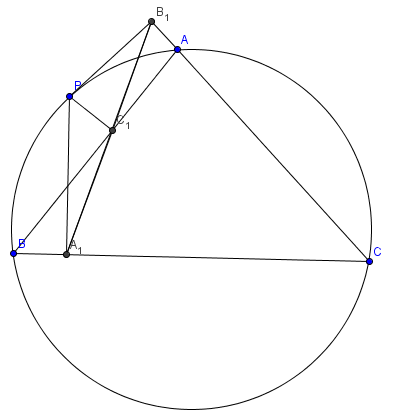
Simson line (main)
Let a triangle ![]() and a point
and a point ![]() be given.
be given.
Let ![]() and
and ![]() be the foots of the perpendiculars dropped from P to lines AB, AC, and BC, respectively.
be the foots of the perpendiculars dropped from P to lines AB, AC, and BC, respectively.
Then points ![]() and
and ![]() are collinear iff the point
are collinear iff the point ![]() lies on circumcircle of
lies on circumcircle of ![]()
Proof
Let the point ![]() be on the circumcircle of
be on the circumcircle of ![]()
![]()
![]() is cyclic
is cyclic ![]()
![]()
![]() is cyclic
is cyclic ![]()
![]() is cyclic
is cyclic ![]()
![]() and
and ![]() are collinear as desired.
are collinear as desired.
Proof
Let the points ![]() and
and ![]() be collinear.
be collinear.
![]() is cyclic
is cyclic ![]()
![]() is cyclic
is cyclic ![]()
![]()
![]()
![]() is cyclis as desired.
is cyclis as desired.
vladimir.shelomovskii@gmail.com, vvsss
Simson line of a complete quadrilateral
Let four lines made four triangles of a complete quadrilateral. In the diagram these are ![]()
Let ![]() be the Miquel point of a complete quadrilateral.
be the Miquel point of a complete quadrilateral.
Let ![]() and
and ![]() be the foots of the perpendiculars dropped from
be the foots of the perpendiculars dropped from ![]() to lines
to lines ![]() and
and ![]() respectively.
respectively.
Prove that points ![]() and
and ![]() are collinear.
are collinear.
Proof
Let ![]() be the circumcircle of
be the circumcircle of ![]() be the circumcircle of
be the circumcircle of ![]() Then
Then ![]()
Points ![]() and
and ![]() are collinear as Simson line of
are collinear as Simson line of ![]()
Points ![]() and
and ![]() are collinear as Simson line of
are collinear as Simson line of ![]()
Therefore points ![]() and
and ![]() are collinear, as desired.
are collinear, as desired.
vladimir.shelomovskii@gmail.com, vvsss
Problem
Let the points ![]() and
and ![]() be collinear and the point
be collinear and the point ![]()
Let ![]() and
and ![]() be the circumcenters of triangles
be the circumcenters of triangles ![]() and
and ![]()
Prove that ![]() lies on circumcircle of
lies on circumcircle of ![]()
Proof
Let ![]() and
and ![]() be the midpoints of segments
be the midpoints of segments ![]() and
and ![]() respectively.
respectively.
Then points ![]() and
and ![]() are collinear
are collinear ![]()
![]()
![]() is Simson line of
is Simson line of ![]() lies on circumcircle of
lies on circumcircle of ![]() as desired.
as desired.
vladimir.shelomovskii@gmail.com, vvsss





